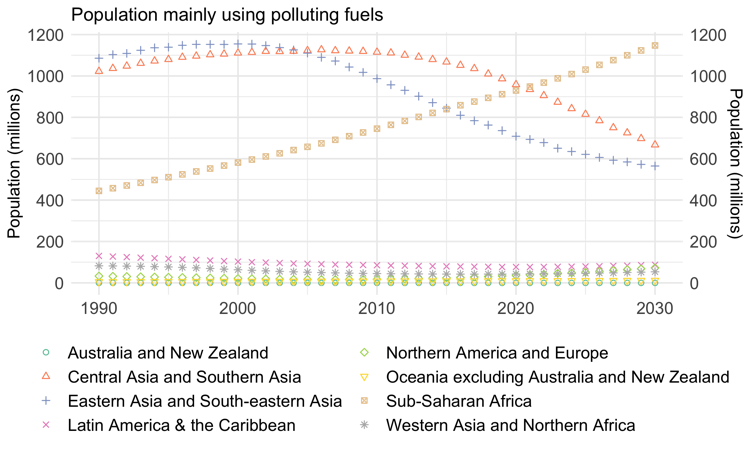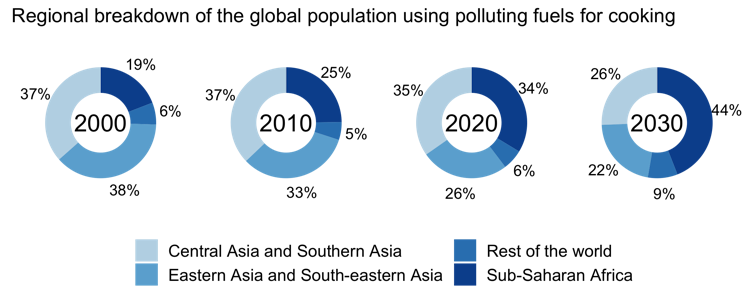
Oliver Stoner, University of Glasgow
In wealthy countries, most people can barely imagine using anything other than electricity or gas to cook in their homes. But billions of people around the world, including the majority of Africans and most of the world’s rural population, rely on polluting fuels like wood or charcoal for their cooking energy needs.
These fuels emit dangerous levels of household air pollution, including fine particulate matter and carbon monoxide, increasing risks of heart disease, stroke, lung cancer and pneumonia, among other noncommunicable diseases. It is no surprise then that the World Health Organisation (WHO) has attributed millions of premature deaths per year to polluting cooking.
Open fires and poorly balanced pots are also hazardous to the families that use them, risking burns and scalds. And fuel collection is often tasked to women and children, reducing opportunities for education or income generation, and thus perpetuating gender inequalities.
Human suffering is reason enough for action. But the harvesting and production of polluting fuels also degrades the environment. They are a significant source of black carbon and greenhouse gases, fuelling climate change.
The target of universal clean cooking is enshrined in Sustainable Development Goal 7 (SDG7) “to ensure access to affordable, reliable, sustainable and modern energy”. For decades, efforts to reduce household air pollution exposure have been informed, tracked, and motivated by estimates of worldwide polluting fuel use. The estimates are produced using statistical models of household survey data. They tend to treat polluting fuels as a group.
Our research was an effort to refine the measurements and estimates. We distinguished between the specific fuels used, using sophisticated Bayesian statistical methods and more of the information in household surveys.
Our research provides estimates for the use of six types of fuel – electricity, gaseous fuels, kerosene, biomass, charcoal and coal. By projecting recent trends into the future, we were able to gain insights into future fuel use under a “business-as-usual” scenario. This shows the world is far off track from achieving Sustainable Development Goal 7.
Slow global progress disguises regional concerns
Overall, our estimates suggest use of polluting fuels is slowly declining, both as a percentage of the global population and in terms of the absolute number of people. Just over a third of people mainly used polluting fuels in 2020, a clear drop compared to 1990, when just over half of people did the same.
The use of clean fuels as the main cooking fuel is increasing in rural areas (particularly gas and electricity).
This progress should be celebrated. But our future projections suggest that without accelerated progress, just under one in three people will still be mainly using polluting fuels in 2030.
Our regional analysis highlights a deeply worrying trend: the number of people using mainly polluting fuels in sub-Saharan Africa is rising at an alarming rate and is due to exceed 1 billion people by 2025. This is happening because progress towards cleaner cooking in this region has been far too slow to keep up with population growth.

Ten years ago, only 25% of the world’s polluting fuel users lived in sub-Saharan Africa. If trends continue, we found that this figure would rise to 44% in 2030, with as many as four in five people mainly using harmful fuels here.

Analysis at the level of specific fuels reveals further insights. Our estimates show a near global elimination of kerosene and coal for cooking, and the emergence of charcoal as the most popular fuel in urban sub-Saharan Africa.
A greater understanding of what fuels people are using can help pre-empt barriers to future adoption of clean cooking. These barriers include affordability constraints and cultural preference for solid fuels.
All our estimates are published for free download as supplementary data. Future updates to these estimates will be posted to the WHO Global Health Observatory data repository.
Renewed action is needed
This research presents a clear warning to policymakers that the frontline in addressing household air pollution is now firmly in sub-Saharan Africa. There can be no global success while the number of people mainly using polluting fuels in sub-Saharan Africa is increasing by tens of millions every year.
Global decreases in polluting fuel use are also heavily reliant on progress in a handful of highly populous countries. For the 2021 edition of Tracking SDG7: The Energy Progress Report, we compared the percentage using clean fuels in the 5 most populous low- and middle-income countries to the overall global percentage, and to the percentage in all other low- and middle-income countries. Worryingly, progress in the latter group was negligible, especially in the last decade.

The Energy Progress Report highlights a need for “greater political will at national level” as a vital step towards cleaner cooking. The report suggests that “all household energy needs, including cooking energy and electricity access, should be integrated in a national energy plan” … to “help governments decide where to direct available resources, what solutions to support or leverage, and which communities to target.”![]()
Oliver Stoner, Lecturer in Statistics, University of Glasgow
This article is republished from The Conversation under a Creative Commons license. Read the original article.

